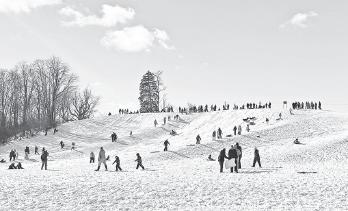
3 minute read
Delving Into Yester~Year
Local historian and writer Paul Miner uses items from The Republican’s Yester- Year column to develop an interesting, informative and often humorous article.
To the Editor: The Plainfield M.E. church pastor watched a Friday night dance Feb. 14, 1896, “to observe how dangerous is the enticing waltz and the seductive quadrille.” Come Sunday, he preached about it. Imagine if he’d seen the Twist or perhaps break dancing, twerking or peeked in at a rave. What if he saw Marilyn Manson there? Someone would be delivering a sermon over him. He was unaware of The Republican’s published dance etiquette.
Advertisement
The gentleman never laid his bare hand on a lady’s waist at the waltz. If he had no gloves, then “carry a handkerchief in the hand.”
But what if he mistakenly packed a big ole wadded-up red paisley nose-blowing bandanna?
The gentleman’s arm never was to encircle the lady’s waist before the waltz music started, and once it was over, then hands to yourself.
Ladies never were to brag about how many dances they had lined up.
If he reeked of liquor or tobacco, the gentleman should not enter “the presence of ladies” in the ballroom. The Republican gave no advice on bathing. If the dance was on a Friday and Saturday was bath night, and you raised hogs, well . . .
A jealous husband fired through a ballroom window when he saw his wife dancing with another man in Austin, Texas, in 1879, but the couple was waltzing so fast that he accidentally pistol shot his wife. It was only a shoulder wound.
In a fit of primness, The Republican denounced Thanksgiving 1881 entertainments, including dancing, mirth, wrestling, dog fights and turkey shoots.
The Republican described some complicated German dancing rituals in January 1882. For one dance, all the women stand behind a nearly closed door and poke their little fingers out. Gentlemen choose a finger and dance with whoever is attached to it.
Or, a lady sits in the middle of the room with a high hat at her feet. A handkerchief is atop that. The gentleman stoops down balanced on one leg and snags the handkerchief with his teeth. I guess they dance after that, and I know what he does with that handkerchief.
In yet another, the lady stands on a chair holding a lighted candle aloft. Gentlemen take turns jumping in the air and trying to blow out the candle. The winner gets to dance with the lady.
I’ve mentioned that September 1883 Brownsburg party where a fight over dance numbers led to a fatal shooting and a lengthy prison sentence. After the victim was shot, slashed and kicked, “It is hardly necessary to state that this episode spoiled the enjoyment of the occasion and broke up the dance.”
A mere wounding, I gather, would not have ended the party. Crowd surfing or a mosh pit would have been considered tame in those tough times.
Someone told Lizton girls in June 1884 that a dance was “a preparatory step to something worse.” Two correspondents declared dancing led to failure in life.
Parlor balls were especially bad. New York City’s police chief in January 1882 claimed three-fourths of abandoned girls were “ruined by dancing.” During dancing, male partners took liberties. Parlor dancing led to “ungodly balls.” A young bully from a neighboring county barged in on a dance in northeastern Kentucky in 1882. The bully and his posse danced with the girls and wouldn’t allow any local boys a chance. A local hero, “the best pugilist,” was summoned, he started dancing a Virginia reel with a girl, and before long pistols replaced fists, the bully was dead and the other was wounded. Whether the fracas broke up the dance was not reported. A willful young wife and mother, against her husband’s wishes, attends a stately ball, has regrets, leaves early and returns home to discover her baby, Herbert, at death’s door. Repentant, she begs her husband’s forgiveness, which he grants, and Herbert recovers. No more dissipation, pursuit of pleasure, willfulness and waywardness in that 1882 short story in the paper. It was a close call.
Late one April 1883 night in Reno, residents were roused by bottles “jingling on the sawdust pile” and some good-looking girls displaying their “captivating” dancing skills. “Old folks say that such performances might do after night, but look bad in daytime.”
Paul Miner Lizton











